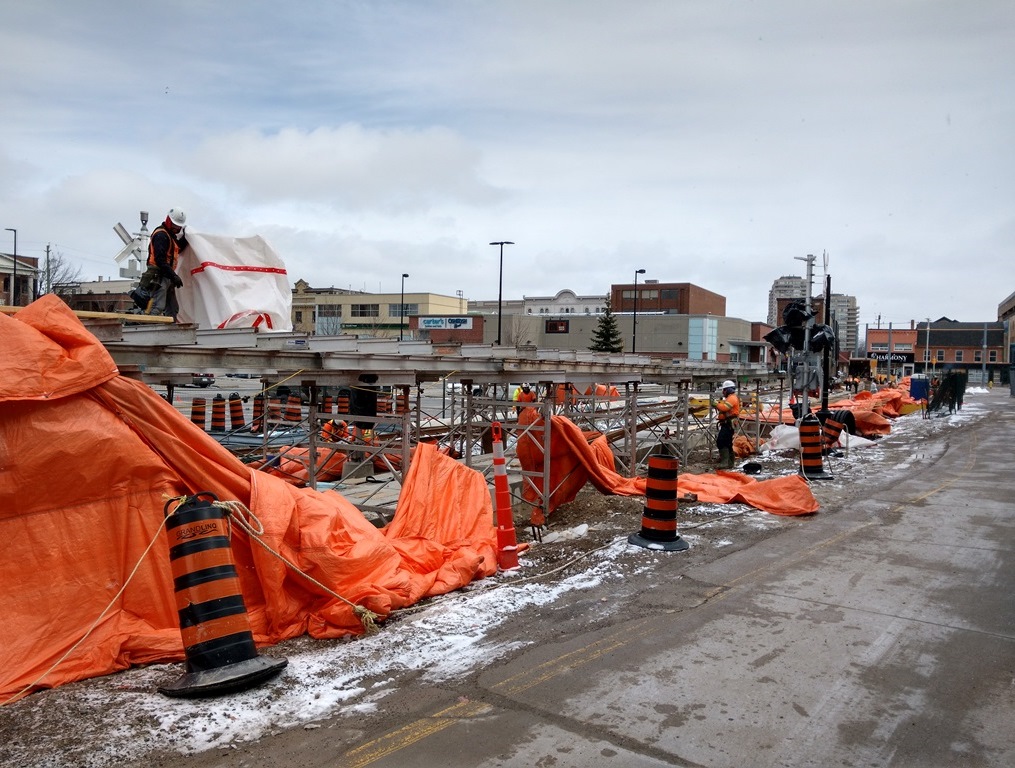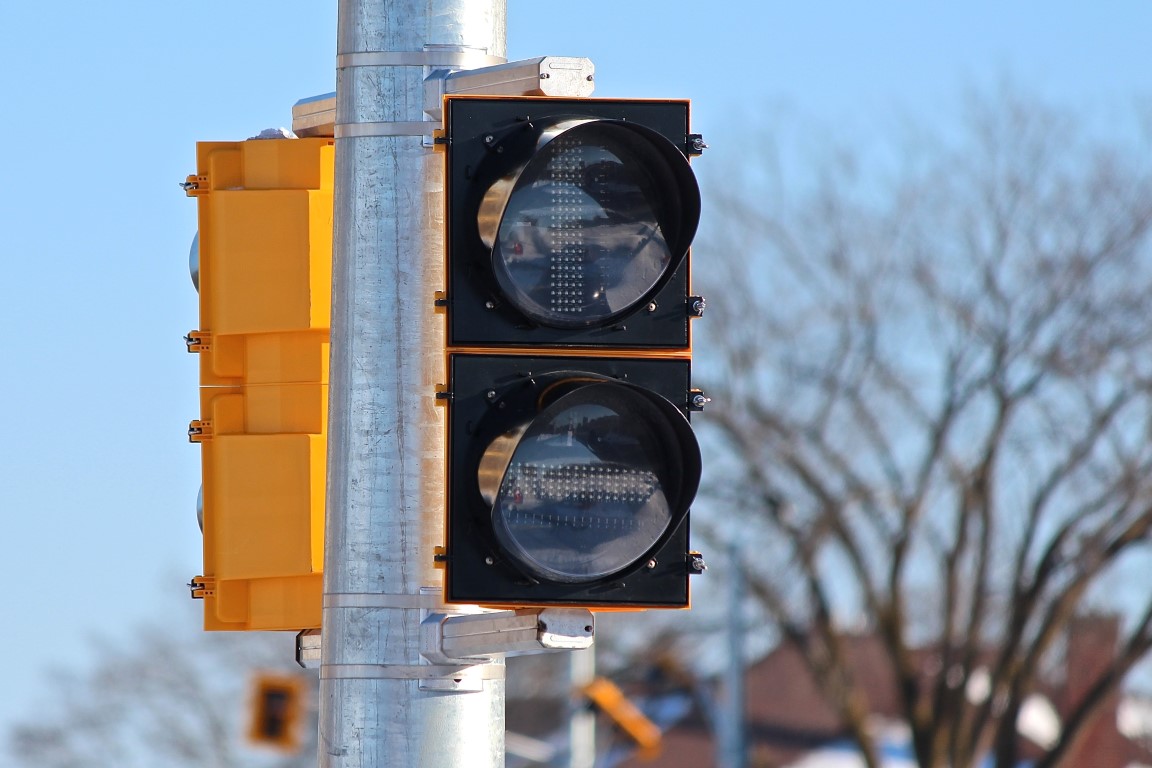Posts: 6,905
Threads: 32
Joined: Oct 2014
Reputation:
224
It's also visible from much further away. If you're 100 m away, you can't read the LED signboard on the platform. But you can see the logo pulsing and know you'd better book it.
A really cynical and pessimistic part of me wonders if this is exactly why they aren't doing it - fears that people will run for a train and get hit by it in the process.
Posts: 667
Threads: 0
Joined: Feb 2017
Reputation:
26
(03-01-2017, 10:10 PM)Canard Wrote: 1/2 - Sunday, February 26, 2017
If they can make these signs illuminate when a train is approaching, why can't they figure out how to do the same with the ION logos on the Anchor Walls?
These signs operate in more of a binary fashion for trains. Either on or off. When it comes down to the dimmable/pulsing sign it's more complex. There are multiple ways to programmably dim an LED each one has it's own disadvantages. The most appropriate method (Digital Addressable Lighting Interface) is quite expensive and requires some pretty sophisticated programming to achieve what we would be looking for. There's also an accuracy question. The No Turn TRAIN signs activate when the train is within a set distance from the controlled area (and usually through some sort of track ciruit, induction loop sensor or other sensor method). How accurate would we want the dimmable/pulsing sign? Would we want the sign to pulse faster the closer the train is? Or would the sign simply get brighter the closer the train is? How accurately can we track the train? What happens if there are gaps in train location data? These are all
Posts: 1,935
Threads: 102
Joined: Aug 2014
Reputation:
18
In my experience (maybe this is a gross simplification of the issue) the most common way of changing brightness of an LED is through pulse width modulation, which can be a fairly straightforward circuit and firmware . I don't have any idea how complex this lighting fixture would be compared to a standard LED, whether it consisted of 1 LED or 100s but I would have thought something like this would have been specified in the contract with Grandlinq.
Posts: 6,905
Threads: 32
Joined: Oct 2014
Reputation:
224
03-02-2017, 07:32 AM
(This post was last modified: 03-02-2017, 08:01 AM by Canard.)
Trainspotter: Washington DC figured out how to do it in the 70's. It is not hard.
Anyway, it turns out the reason why it's not happening isn't technical.
Posts: 495
Threads: 1
Joined: Jan 2015
Reputation:
20
/\ Purely a question of cost?
Posts: 103
Threads: 0
Joined: Aug 2016
Reputation:
2
The light-up iON logo does sound cool but I always wondered how you would be able to tell which way the upcoming train was going, from a distance. If it only lit up on the side that was coming then it wouldn't help you if you were approaching from the wrong side of the platform.
Posts: 6,905
Threads: 32
Joined: Oct 2014
Reputation:
224
Aspect Signals are all on between at least Erb/Caroline and South as far as about Ontario, I think. I noticed today for the first time that Water actually doesn't have any.
Mass Electric was setting up at Borden/Charles, getting ready to string the next strand of Contact Wire down along Borden/the Huron Spur, up to the next tensioner.
Posts: 77
Threads: 2
Joined: Jan 2015
Reputation:
12
More of the hoarding at Waterloo Town Square is coming down today. Also looks like they're preparing to continue pouring the station platform.

Posts: 77
Threads: 2
Joined: Jan 2015
Reputation:
12
LRT lights are operational this morning at intersections on Charles (at Water and Gaukel). It almost looked like a train might come around the corner, but the lack of catenary cables squashed that excitement  . I wonder if having these lights operating so early will help educate motorists/pedestrians or make them complacent.

Posts: 1,476
Threads: 5
Joined: Sep 2014
Reputation:
41
Personally, as a driver encountering this kind of signal for the first time (at William and Caroline), I was confused. My first assumption, based on its general location, was that the signal was a malfunctioning pedestrian signal. If I recall correctly, this lit portion of the signal is the lower of two boxes that looks similar to a pedestrian signal. Perhaps when I see both the top and bottom boxes lit while the system is working, it will become more clear.
Posts: 6,905
Threads: 32
Joined: Oct 2014
Reputation:
224
03-03-2017, 02:10 PM
(This post was last modified: 03-03-2017, 02:17 PM by Canard.)
Lower lamp is "-", or stop. The upper lamp is "|", or proceed.

They really should have had the safety campaign mention this (and push it a little harder toward the media) before powering them up. That being said, a big red light still means stop, and a big green one still means go! The reason for going with a "white" "bar" is because neither of those things are colours or shapes that a driver encounters in any other condition, with the idea that a state change won't trigger a false "Go" in the mind of a motorist. Anyone who has ever sat at a stoplight and watched cars around instinctively lift their foot off the brake when an adjacent lane gets an advanced green knows exactly what I'm talking about.
Posts: 1,709
Threads: 2
Joined: Aug 2014
Reputation:
34
The safety concern is valid. Those lights are very much at pedestrian height and location. In Downtown on Charles, I've had to do double-takes now because of the colour and location. Some people might look quickly and see white light and think they can cross, when in fact it is just the LRT signal and not the walk signal that is providing the white light. For people with less-than-perfect vision, this can become even more of a concern.
Another side note: holy moly are those signals bright. If you're within their primary light angle, they are painful to look at. If you're a pedestrian, the white light from these will definitely be more powerful and noticeable than white light from the pedestrian walk signal.
Posts: 6,905
Threads: 32
Joined: Oct 2014
Reputation:
224
Hmm, I hadn't considered people walking might mistake them.
Maybe they should have made them blue!
Posts: 62
Threads: 0
Joined: Jun 2016
Reputation:
1
(03-03-2017, 02:10 PM)Canard Wrote: Lower lamp is "-", or stop. The upper lamp is "|", or proceed.
They really should have had the safety campaign mention this (and push it a little harder toward the media) before powering them up. That being said, a big red light still means stop, and a big green one still means go! The reason for going with a "white" "bar" is because neither of those things are colours or shapes that a driver encounters in any other condition, with the idea that a state change won't trigger a false "Go" in the mind of a motorist. Anyone who has ever sat at a stoplight and watched cars around instinctively lift their foot off the brake when an adjacent lane gets an advanced green knows exactly what I'm talking about.
Part of the confusion is that they look like regular traffic light signals at least like the walk / don't walk kind for pedestrians. Maybe it would helpf if they were horizontal or othwerise made to look more distinct than regular signals
Posts: 667
Threads: 0
Joined: Feb 2017
Reputation:
26
(03-03-2017, 03:08 PM)NotStan Wrote: (03-03-2017, 02:10 PM)Canard Wrote: Lower lamp is "-", or stop. The upper lamp is "|", or proceed.
They really should have had the safety campaign mention this (and push it a little harder toward the media) before powering them up. That being said, a big red light still means stop, and a big green one still means go! The reason for going with a "white" "bar" is because neither of those things are colours or shapes that a driver encounters in any other condition, with the idea that a state change won't trigger a false "Go" in the mind of a motorist. Anyone who has ever sat at a stoplight and watched cars around instinctively lift their foot off the brake when an adjacent lane gets an advanced green knows exactly what I'm talking about.
Part of the confusion is that they look like regular traffic light signals at least like the walk / don't walk kind for pedestrians. Maybe it would helpf if they were horizontal or othwerise made to look more distinct than regular signals
Considering most pedestrian signals in the region are countdown signals where the top one is a combined Walk / Don't Walk and the bottom a countdown timer i don't see the confusion. The pedestrian signals at these intersections are sligntly higher and are directly across from where pedestrians are crossing for a reason.
|




 . I wonder if having these lights operating so early will help educate motorists/pedestrians or make them complacent.
. I wonder if having these lights operating so early will help educate motorists/pedestrians or make them complacent.